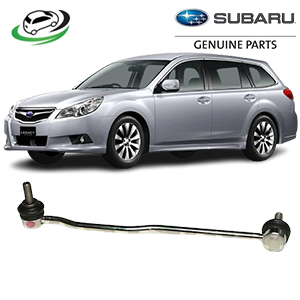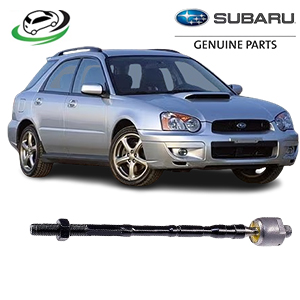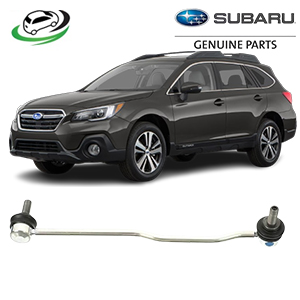-8%
Get Subaru Outback BS9 Front Stabilizer Link RH 20420AL001
The front stabilizer link, often referred to as the sway bar link or anti-roll bar link, is a vital component in a vehicle’s suspension system. Specifically, the Front Stabilizer Link RH (right-hand) connects the sway bar to the right side of the suspension, playing a crucial role in vehicle stability and handling. Understanding its functions, benefits, maintenance practices, and replacement procedures is essential for vehicle owners and automotive enthusiasts alike.
1. What is the Front Stabilizer Link RH?
The front stabilizer link RH is a metal rod that connects the right side of the sway bar to the suspension components, usually the lower control arm or strut assembly. It typically consists of a threaded rod with rubber or polyurethane bushings on each end, allowing for some flexibility while maintaining a secure connection.
The sway bar’s primary function is to reduce body roll during cornering, improving the vehicle’s handling characteristics. The stabilizer link ensures that the sway bar operates effectively, contributing to a stable and comfortable driving experience.
2. Functions of the Front Stabilizer Link RH
The front stabilizer link RH performs several essential functions within the suspension system:
a. Stabilization During Cornering
One of the primary roles of the stabilizer link is to stabilize the vehicle during turns. When a vehicle corners, centrifugal force causes it to lean toward the outside of the turn. The sway bar, connected via the stabilizer link, helps counteract this lean, ensuring that all four tires maintain contact with the road.
b. Improved Handling and Control
By reducing body roll, the stabilizer link enhances the vehicle’s overall handling and control. This leads to a more responsive driving experience, allowing drivers to navigate corners and maneuvers with confidence.
c. Enhanced Ride Quality
The stabilizer link contributes to a smoother ride by minimizing excessive body movements. A well-functioning stabilizer link helps absorb shocks and vibrations, leading to a more comfortable experience for passengers.
d. Supporting Suspension Components
The stabilizer link helps maintain the alignment and positioning of other suspension components. By keeping the sway bar level, it reduces the stress on adjacent parts, potentially prolonging their lifespan.
3. Benefits of a Properly Functioning Front Stabilizer Link RH
Maintaining a properly functioning front stabilizer link RH offers numerous benefits for vehicle performance and safety:
a. Improved Vehicle Stability
A healthy stabilizer link ensures a stable ride, especially during sharp turns or lane changes. This stability is crucial for preventing loss of control, which can lead to accidents.
b. Enhanced Cornering Performance
With reduced body roll, a vehicle equipped with a functional stabilizer link can corner more effectively. This performance improvement enhances the driving experience and overall handling characteristics.
c. Increased Safety
A well-maintained suspension system, including the stabilizer link, contributes to overall vehicle safety. By ensuring stability and control, the stabilizer link helps reduce the risk of rollovers and improves the vehicle’s response during emergency maneuvers.
d. Extended Suspension Component Life
Supporting the correct alignment of suspension components helps prolong the lifespan of other parts in the system. This can lead to lower maintenance costs and fewer repairs over time.
e. Enhanced Comfort
A properly functioning stabilizer link contributes to a more comfortable ride by minimizing excessive body movements. This comfort improves the overall driving experience for both the driver and passengers.
4. Signs of a Failing Front Stabilizer Link RH
Recognizing the signs of a failing front stabilizer link RH is crucial for preventing more extensive suspension damage and maintaining optimal vehicle performance. Common indicators of a worn or damaged stabilizer link include:
a. Clunking or Rattling Noises
One of the most noticeable signs of a failing stabilizer link is clunking or rattling noises coming from the suspension area. These sounds are often more pronounced when driving over bumps or uneven surfaces, indicating that the link or its bushings may be worn out.
b. Increased Body Roll
If you notice increased body roll during cornering, it may signal a failing stabilizer link. A compromised link may not effectively counteract body movements, leading to a less stable driving experience.
c. Uneven Tire Wear
Worn stabilizer links can contribute to improper alignment, resulting in uneven tire wear. If you notice that your tires are wearing more on one side, it may indicate suspension issues related to the stabilizer link.
d. Steering Wheel Vibrations
Excessive vibrations in the steering wheel, especially during turns or on rough roads, can signal suspension problems. A failing stabilizer link can affect the vehicle’s handling, causing vibrations that are felt through the steering system.
e. Visual Inspection
A visual inspection can reveal signs of wear, such as cracked or damaged bushings, bent links, or rust. If any visible damage is present, it is essential to replace the stabilizer link promptly.
5. Maintenance of the Front Stabilizer Link RH
Regular maintenance of the front stabilizer link RH is vital for optimal vehicle performance and safety. Key maintenance practices include:
a. Routine Inspections
Conduct regular inspections of the stabilizer links during routine vehicle maintenance. This includes checking for visible wear, looseness, or damage to the link and its bushings.
b. Monitor for Noises
Pay attention to any unusual noises coming from the suspension area, particularly when driving over bumps. Early detection of clunking or rattling sounds can help identify potential issues before they worsen.
c. Replacement Guidelines
Refer to your vehicle’s owner manual for specific recommendations on when to replace the stabilizer links. Generally, these components should be replaced every 50,000 to 100,000 miles or as needed based on wear and performance.
d. Professional Assistance
If you are unsure about the condition of your stabilizer links or lack the tools to inspect them, consider seeking professional assistance. A qualified mechanic can assess the links and recommend necessary repairs or replacements.
e. Address Related Suspension Issues
If you notice any signs of wear or failure in the stabilizer links, check for related suspension issues. Addressing any underlying problems can help prevent premature wear of the new components.
6. Steps to Replace the Front Stabilizer Link RH
Replacing the front stabilizer link RH is a relatively straightforward process that can typically be performed with basic tools. Here’s a general outline of the steps involved:
- Gather Necessary Tools
You will need basic hand tools, including a socket set, wrench, and possibly a torque wrench. Have the replacement stabilizer link on hand. - Lift the Vehicle
Safely lift the vehicle using a jack and secure it with jack stands to prevent accidental movement. Ensure the vehicle is on a level surface for stability. - Locate the Stabilizer Link
Find the stabilizer link on the right side of the vehicle’s suspension. It connects the sway bar to the lower control arm or strut assembly. - Remove the Old Link
Using the appropriate socket and wrench, remove the nuts securing the stabilizer link to the sway bar and lower control arm. You may need to use a penetrating oil to loosen any rusted or seized nuts. - Inspect Surrounding Components
Before installing the new link, inspect surrounding suspension components for wear or damage. Address any issues before proceeding with the replacement. - Install the New Link
Position the new stabilizer link in place, aligning it with the sway bar and lower control arm. Secure it with the nuts, ensuring they are tightened to the manufacturer’s specifications. - Lower the Vehicle
Carefully lower the vehicle back to the ground and remove the jack stands. Ensure everything is properly secured before driving. - Test Drive the Vehicle
After the replacement, take the vehicle for a test drive. Pay attention to the handling, ride quality, and any noises coming from the suspension area to ensure everything is functioning correctly.
Conclusion
The front stabilizer link RH is a critical component of a vehicle’s suspension system, playing a vital role in maintaining stability, handling, and ride quality. Understanding its functions, benefits, maintenance practices, and signs of wear can help vehicle owners take proactive steps to ensure their suspension systems remain in optimal condition. Regular inspections and timely replacements of stabilizer links contribute to improved vehicle performance, enhanced safety, and a more enjoyable driving experience. By keeping this essential component well-maintained, drivers can enjoy a smoother ride and greater peace of mind on the road.
Follow us on Facebook for more parts.




Reviews
Clear filtersThere are no reviews yet.